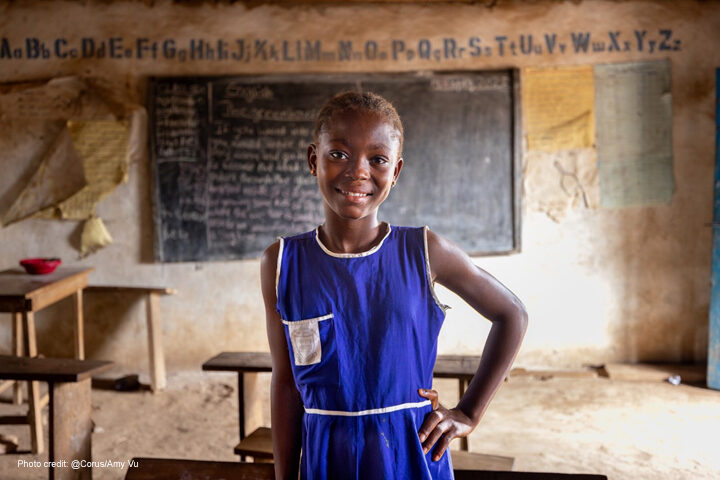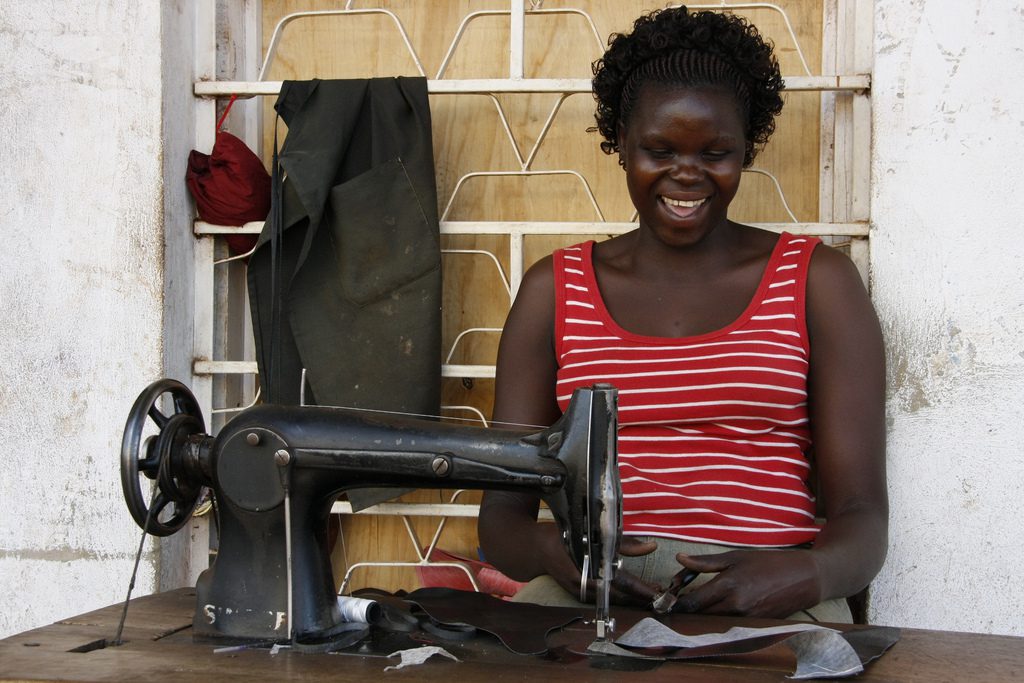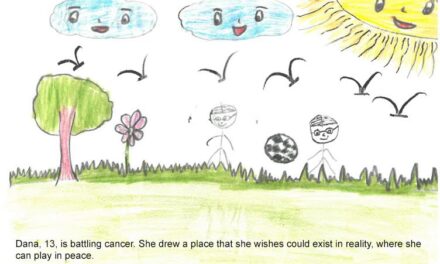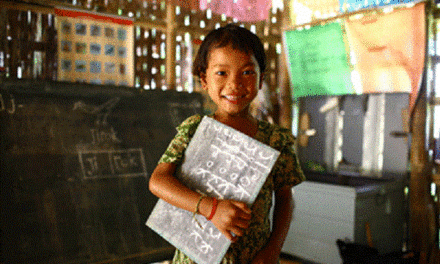This blog was written by Hannah Graham, Managing Director of CGA Technologies, based on her presentation from the September 2025 UKFIET conference. It is also published on the CGA Technologies website.
Summary: With out-of-school populations rising, inclusion and intersectionality matter more than ever, but as education aid plummets, innovations are urgently needed. By leveraging existing systems and building collaboration it is possible to continue to reach the most vulnerable at scale – efficiently, effectively and sustainably.
Despite decades focused on developing inclusive education systems that address the needs of the most marginalised (with many notable gains and improvements), the global population of out-of-school children has increased by 21m to 272m.
With education aid projected to fall 25% between 2023 and 2027, some will ask, “can we continue to target the hardest to reach or should attention shift to scale?”
The answer is neither. Instead, there is a third way: innovation that leverages existing systems and services to reach the most vulnerable – more efficiently, effectively, sustainably and – crucially – doing so at scale.
Leading with data
At the UKFIET 2025 conference, I introduced preliminary results from the first year of the Girls In School Initiative (GISI), a unique data-led CashPlus[i] education programme aimed at increasing school attendance and retention rates among vulnerable girls in Sierra Leone.
Its uniqueness comes from leveraging data from an existing government-owned data system (Wi De Ya – a teacher and learner enrolment and attendance monitoring system developed by CGA Technologies) to identify and target the most vulnerable in school girls as well as formerly out-of-school girls to receive lightly conditional monthly cash payments, delivered via mobile money.
That same platform, utilised by teachers and government staff, is then used to monitor the girls’ attendance. Those with poor attendance are flagged for follow-up and linked to existing complementary services, such as health, counselling, legal support, and disability or child protection services.
Our theory being that, by adopting a data-led approach and using robust, highly disaggregated data which continuously flows in from existing government systems, we eliminate the need for standalone needs assessments, large-scale surveys and resource heavy monitoring, making GISI more efficient and cost-effective.
Early findings: Encouraging attendance gains
The impact of GISI on participating girls’ school attendance is encouraging, demonstrating that leveraging existing mainstream systems to target vulnerable learners can be effective without requiring major additional expenditure or parallel, unsustainable structures.
Over its pilot year (AY 2024/25), GISI, which is funded by Corus International, targeted 853 vulnerable primary school girls and former out-of-school girls throughout the academic year. Preliminary findings[ii] drawn from the profiles and twice-daily attendance records of more than 12,000 learners (including those who received cash transfers) indicate a modest but significant improvement in school attendance among participating girls. From January to April, their attendance was 4 percentage points higher than both the 88% average of all learners and the control group.
Over-age learners were significantly more responsive. Within each age group, the attendance of programme participants was 3.5 percentage points higher than non-participants, except among learners aged 14-16 where the attendance of those receiving cash was 10 percentage points higher than those who didn’t.
Girls and caregivers reported wider gains. Having school materials and uniforms instilled pride in the girls, motivating them to attend school; and they had money to buy lunch, making them more attentive in class. Caregivers reported using cash for food, electricity, medical expenses and hygiene, supporting all household members.
Scalability
The beauty of this approach is its scalability – a hypothesis we are testing as GISI enters its second year. This year we are doubling our efforts to target 2,000 vulnerable girls across 60 primary schools (up from 29 in year one) in five districts (up from four).
As the Education Ministry (Ministry of Basic and Senior Secondary Education) and Teaching Service Commission scale Wi De Ya to all primary schools[iii] and later all Junior and Secondary schools, so then GISI can scale – as can any programme that partners with the Ministry and adopts this framework.
The Global Education Monitoring Report 2023 cautions practitioners that “technology use [in classrooms] is not universal and will not become so any time soon”. Therefore, our focus in low-resource settings should not be getting children on devices, but empowered teachers, empowered management, and better resourcing. The priority should be on developing processes and systems – knowing who and where learners are and what their needs are, where teachers are and are not.
Opportunity: From silos to collaboration
GISI shows what is possible when data systems and partnerships are aligned to deliver greater impact—a critical need as education budgets come under increasing strain.
Across the sector, siloed systems and disconnected programmes drive duplication and inefficiency. By contrast, governments are investing in core critical digital infrastructure to strengthen their own services. When education partners work through these systems, they not only boost efficiency and sustainability, but also help build national capacity and coherence. Interoperability at the national level is key: this is where resources and data are most effectively aligned with population needs.
Maximising impact through shared government data systems
Access to government-owned systems gives all partners a single, trusted source of information, reducing duplicative data management costs and ensuring more funding is directed where it is most needed. Embedding programmes in government systems also strengthens digital public infrastructure, while giving stakeholders—government and project staff alike—the tools to work transparently and with greater control.
Creating meaningful digital public infrastructure is not about launching new platforms but about connecting existing systems with new solutions in ways that are realistic, sustainable, and rooted in government structures and processes. That requires interoperability, long-term support, and above all, collaboration—project teams, government staff, and partners aligning data and processes from the outset.
As attention turns to technologies like AI, getting digital public infrastructure right is even more pressing—so that the education data feeding into it is robust, accurate and used effectively and ethically to serve the most vulnerable.
The building blocks already exist. What is needed now is a collective commitment across the education sector to use them to their fullest, ensuring scarce resources go further and the most vulnerable children continue to receive the support they need—efficiently, effectively and sustainably.
—–
Note: In the second phase of the Girls In School Initiative (AY25/26), CGA Technologies will scale the programme to target 2,000 vulnerable girls across five districts in Sierra Leone. GISI is only possible thanks to collaboration with the Ministry of Basic and Senior Secondary Education, which permits us to access and use select Wi De Ya data to deliver the programme. CGA’s sister organisation, LWR, is also implementing the programme in Mali.
[i] [i]Cash Plus interventions combine cash transfers with complementary, context-relevant interventions, in this case intervening to prevent process of school dropout as attendance falls.
[ii] Pending fuller analysis.
[iii] Wi De Ya piloted nationally to 300 government primary schools.





